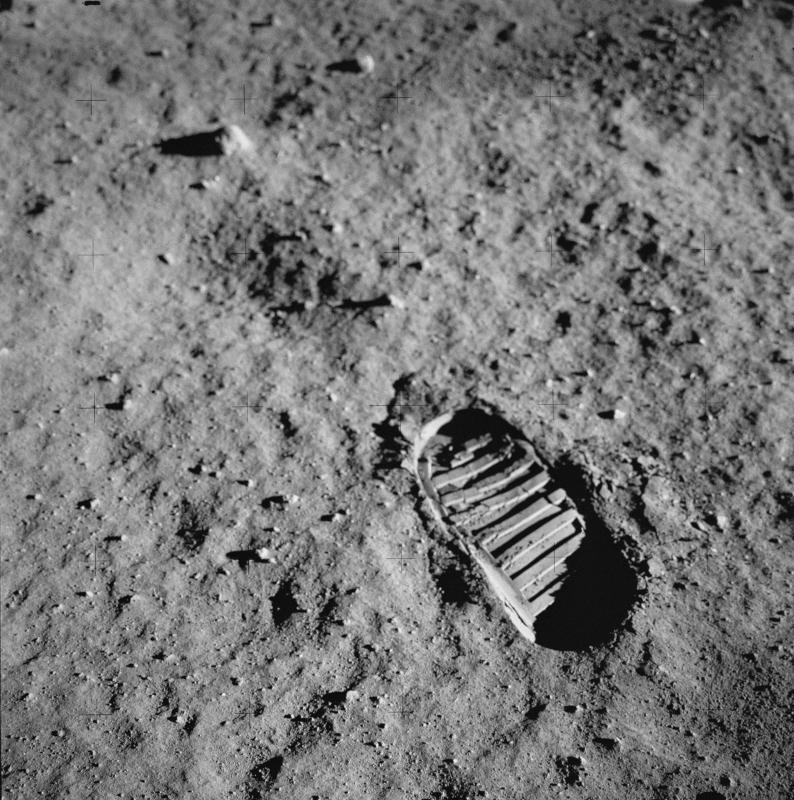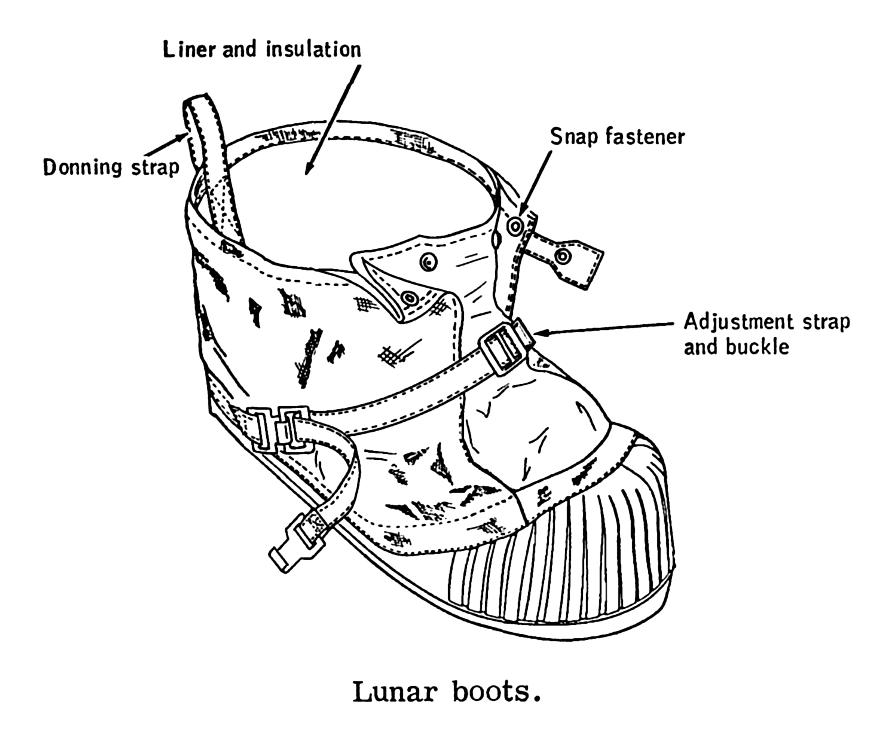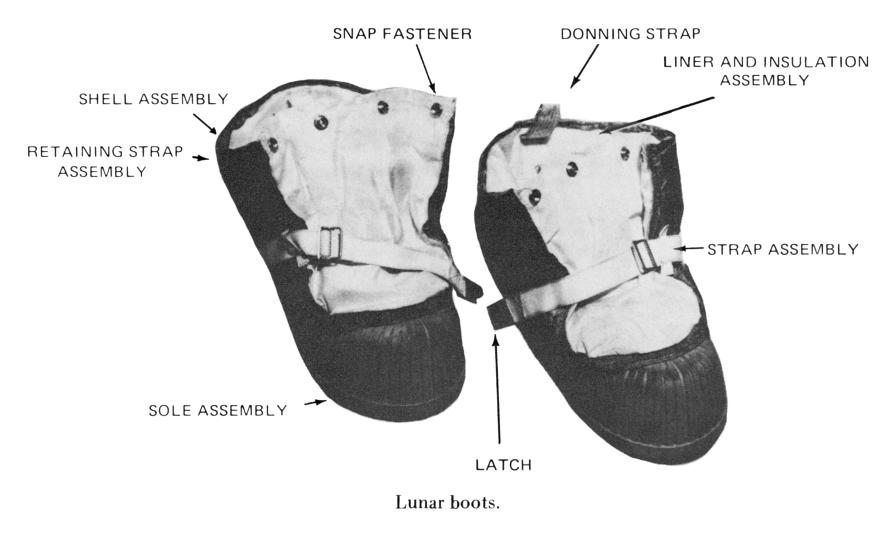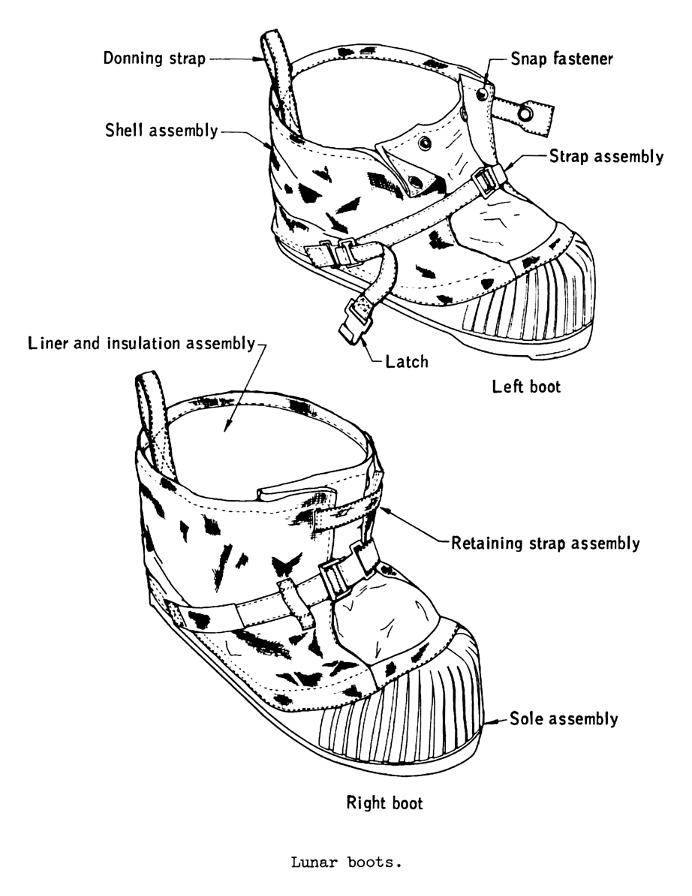Apollo A7L/A7LB Lunar Overboot
One of the most iconic images of the Apollo program is Buzz Aldrin's footprint on the lunar surface:
NASA photo AS11-40-5880.
Click image for additional information regarding this image in a new window.
The boot which left the footprint was simply called the lunar overboot or lunar boot, one of the few parts of the Apollo spacesuit which did not have a long name requiring an acronym for everyday use. This boot was worn over the main space suit (pressure garment assembly, or PGA) boot.
The lunar overboots were donned prior to lunar surface activity and provided thermal and abrasion protection for the PGA boots during lunar surface operations. The outer layer of the lunar overboot, except for the sole, was fabricated from a woven chromium steel fabric called Chromel-R. Chromel-R was a new fabric at the time and cost (depending upon the source of the information) $2,000 or $2,775 per yard. The Chromel-R was qualified to withstand temperatures up to 1,200° F and also provided a cut-resistant protective barrier between the PGA boot and potentially sharp rocks on the lunar surface.

From page 32 (p. 34 in the PDF) of Apollo A-7L
Spacesuit Development for Apollo 7 Through 14 Missions.
Extraction and restoration by heroicrelics.
The inner layers of the boot varied during the program. For the missions using the A7L suit (Apollo 11 through 14) the inner layers, from outside in, consisted of two layers of Kapton (an aluminized polymid film) followed by five layers of aluminized, perforated Mylar, separated by four layers of nonwoven Dacron (similar to the torso cover layer). The innermost layer consisted of a liner of made Teflon-coated Beta cloth. Two layers of Nomex felt in the sole provided additional thermal insulation from the lunar surface.
The lunar overboot was updated to match the new A7LB suit for Apollo 15 through 17. While the boot was visually identical, the interior layers were changed to include Teflon-coated Beta cloth (fire resistant shell), two layers of Beta marquisette Kapton laminate (outer insulation), nine layers of aluminized Mylar (insulation film) alternating with non-woven Dacron to serve as a spacer, and a Teflon-coated Beta cloth boot liner. Nomex felt served as a thermal boot pad.
The tongue area of both types of boot was made of Teflon-coated Beta cloth.
Each boot's sole was comprised of silicone rubber. Ribs protruded from the bottom of the sole to increase thermal insulation qualities, to provide lateral rigidity, and to provide traction on the lunar surface. The ribs were spaced so as to fit the rungs of the lunar module's ladder.
Click image for a 1499x1249 pixel version of this image in a new window.
From page 2-47 (p. 63 in the PDF) of Apollo Operations
Handbook, Extravehicular Mobility Unit, Volume 1 - System Description, Apollo
14.
Extraction and cleanup by heroicrelics.
To don the boot, the astronaut would open the retaining strap assembly and two snap fasteners to unfold surplus material at the top of the boot's tongue area.
Click image for a 3213x1924 pixel version of this image in a new window.
From page 559 of Biomedical Results of Apollo, NASA SP-368, in the
heroicrelics library. Also available in electronic format from the NASA Technical Reports
Server.
Scan and cleanup by heroicrelics.
The PGA boot would then be inserted into the enlarged upper portion of the lunar overboot, using the donning strap at the rear of the boot to help position the PGA boot within the lunar boot. The surplus material would be refolded and then held closed by reengaging the snap fasteners and the retaining strap. The boot would further be held in place by by a strap assembly extending from the side of the heel and across the instep. This strap incorporated a latching mechanism which could be easily manipulated by the astronaut, even while wearing EVA gloves.
Click image for a 1844x2387 pixel version of this image in a new window.
From page 2-30 (p. 48 in the PDF) of Apollo Operations
Handbook, Extravehicular Mobility Unit, Volume 1 - System Description, Apollo
15-17; alternate
link.
Extraction and cleanup by heroicrelics.
Much of the descriptive text on this page was taken, sometimes verbatim or nearly so, from the Biomedical Results of Apollo, NASA SP-368 and the Apollo Operations Handbook, Extravehicular Mobility Unit, Volume 1 - System Description, Apollo 15-17.
Moon Boot: The Story of the Apollo Lunar Overshoe and the Race to Walk on the Moon contains a history of the development of the lunar overboot. It contains information which contradicts the official NASA publications above, primarily regarding the construction of the inner layers of the boot. Moon Boot's author consulted with some International Latex Corporation engineers, who would presumably have more intimate knowledge of the boots' construction while some of the NASA information seems to have been copy/pasted, nearly verbatim, throughout several documents and so may be less vetted (researched once and then repeatedly quoted).
Nonetheless, I have quoted the NASA material, as they are the official NASA primary source materials and I do not have access to the information used by Moon Boot's author.




